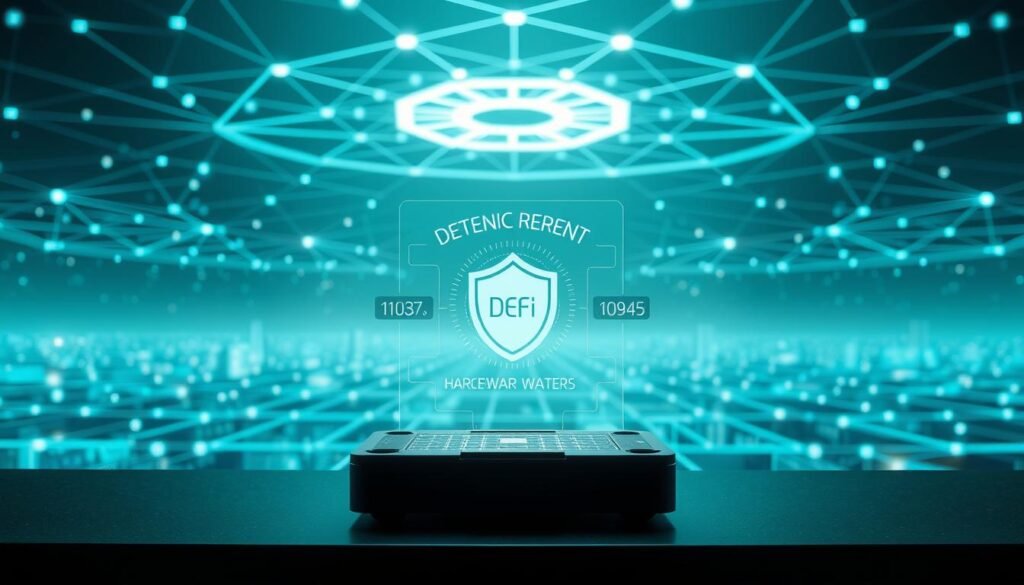Ever wondered how safe your crypto holdings really are when you move them onto a new platform?
DeFi opens an open ecosystem where you can lend, borrow, and trade without banks. That freedom is powerful, but it brings new risks that can cost real funds.
Smart contract bugs, manipulated price feeds, and flash loan attacks have hit well-known projects. Everyday users can learn simple steps to lower exposure and build trust across platforms.
Start with practical habits: use hardware wallets like Ledger or Trezor, favor audited projects, and split holdings across trusted platforms. You don’t need to code to protect assets.
This guide will translate complex concepts into clear actions. Follow along to learn how to check platforms, reduce risks, and keep funds safer while you enjoy what the ecosystem offers.
Key Takeaways
- DeFi gives access to lending and trading without intermediaries, but it adds unique risks.
- Use hardware wallets and prefer audited projects to protect your assets.
- Verify platforms, enable multi-factor controls, and limit exposure to new projects.
- Strong habits by non-developers can greatly improve personal safety.
- Stay informed—industry news, audits, and post-mortems matter for long-term trust.
The state of DeFi security today in the United States
U.S. headlines now often spotlight scams that drain wallets and erode user confidence. Phishing, pump-and-dump schemes, and fake wallets or exchanges show how visible the risks have become.
Because regulation is lighter and access can be permissionless, the same openness that fuels innovation also increases exposure. That reality means users must take charge of account hygiene and platform choice.
Start with established defi platforms that publish audits and post-mortems. Projects with audit histories and active bug-bounty programs have repeatedly proven more resilient after incidents.
Good habits matter: enable MFA, use unique passwords, and consider hardware wallets for offline key storage. These steps pair with on-chain controls to reduce the chance of loss.
Finally, monitor reliable data and community channels. Transparency from teams and a culture of rapid patching and responsible disclosure build trust and help U.S. users stay ahead of emerging threats.
How DeFi works under the hood: blockchain, smart contracts, and wallets
Blockchains lock in each transaction, so transparency comes with permanence and real-world consequences.
Blockchain technology and immutability: trust, transparency, and risks
At their core, blockchains record transactions in a way that is hard to change. That immutability builds trust and makes audits simple.
It also means mistakes or bad transfers can’t be undone. Apps on top of the chain can still have flaws that affect funds.
Smart contracts as automated finance: strengths and vulnerabilities
Smart contracts run code that executes rules automatically. They speed operations and give global access without middlemen.
But coding errors like reentrancy or integer overflow have caused big losses (the DAO is a famous case). Audits and formal checks reduce this risk, but they don’t eliminate it.
Wallets, private keys, and custody choices across platforms
Your wallet is your account. Non-custodial wallets mean you control private keys; custodial services trade control for convenience.
Use hardware devices, back up seed phrases, and consider multi-signature setups for larger shared treasuries. Start with small test transactions and always confirm prompts before signing.
| Layer | What it holds | Typical risk |
|---|---|---|
| Blockchain | Immutable transaction record | Permanent mistakes |
| Smart contracts | Automated contracts and logic | Code bugs (reentrancy, overflow) |
| Wallets | Private keys and approvals | Lost keys or phishing |
The threat landscape: common DeFi attacks and vulnerabilities
A handful of bugs or bad data feeds can let attackers drain pools in minutes. That mix of code flaws, fast capital, and weak price inputs defines today’s threat landscape for defi platforms.
Smart contract bugs that lead to quick losses
Reentrancy lets an attacker call a withdraw loop before balances update. Integer overflows or unchecked external calls can break logic and let funds escape.
Historic incidents like the DAO show how chaining weaknesses costs millions. Audits help, but they do not eliminate all risks.
Flash loan attacks and rapid, uncollateralized exploits
Flash loans give instant capital to manipulate DEX prices or governance in a single transaction. bZx-style events proved attackers can chain moves to drain liquidity.
Oracle and price feed manipulation
Thin liquidity pools and single-source feeds make price data easy to skew. Harvest Finance lost roughly $24M after oracle manipulation.
AMM and liquidity pool exposures
Attacks can amplify impermanent loss, shift prices, and exploit protocol design flaws that hurt both users and LPs.
- Mitigations: CEI patterns, reentrancy guards, TWAP oracles, decentralized feeds, rate limits, and continuous monitoring.
- User advice: read docs, check incident history, and never put all assets in one pool.
| Threat | How it works | Common mitigations |
|---|---|---|
| Reentrancy | Repeated withdraw before state update | Checks-Effects-Interactions, reentrancy guards |
| Flash loan | Instant capital to skew markets | Rate limits, oracle protections, governance safeguards |
| Oracle manipulation | Fake or delayed price data | Decentralized oracles, TWAP, multiple feeds |
Decentralized finance security tips for everyday users
Protecting crypto starts with simple steps that any user can follow, no coding required.

Own your keys: hardware wallets and multi-signature
Use a hardware wallet like Ledger or Trezor to keep private keys offline. That stops many common malware and browser exploits.
For larger balances, set up a multi-signature wallet so no single lost key can move funds alone.
Use exchanges for trading only
Keep exchanges for executing trades, then withdraw assets back to your self-custody wallet. This lowers custodial risk.
Use strong, unique passwords stored in a reputable password manager and enable MFA/2FA on every exchange account.
Beware of phishing and lookalikes
Type URLs manually, bookmark official sites, and verify domains and SSL certificates. Never enter seed phrases on a website or share them in chat.
Regularly review token approvals and revoke unnecessary permissions via trusted tools so malicious dApps cannot drain funds later.
Stay updated and diversify
Keep wallet apps, browser extensions, and firmware up to date; many updates patch critical vulnerabilities.
Split deposits across vetted, audited projects to reduce exposure. Follow reputable researchers, read post-mortems, and treat suspicious offers as red flags.
- Practical practices: own your keys, withdraw after trading, and revoke unused approvals.
- Best practices: use hardware wallets, MFA, and diversify across platforms.
Platform-level best practices that protect your funds
A platform’s engineering and operational controls decide how well user funds survive an incident.
Regular smart contract audits, formal verification, and secure coding
Require multiple independent audits before mainnet launches and after major upgrades. Pair audits with penetration testing and formal verification to catch logic errors early.
Follow secure patterns like Checks-Effects-Interactions and add reentrancy guards. These coding practices reduce common exploit classes for smart contract projects.
Reliable oracles and TWAP to counter manipulation
Use oracle networks such as Chainlink, Band, or API3 that aggregate multiple data sources. Combine those feeds with time-weighted average price (TWAP) logic to resist short, price-based attacks like flash loan events.
Access control, monitoring, and rate limits for robust operations
Enforce least-privilege roles, multisig for admin actions, and time-locked upgrades so the community can review changes. Add rate limiting and automated anomaly detection to blunt rapid exploits.
Maintain on-call playbooks, bug bounties, and public post-mortems to build trust. Periodic re-audits after integrations keep platforms resilient as they evolve.
| Defense | Focus | Benefit |
|---|---|---|
| Audits & verification | Code correctness | Fewer contract bugs |
| Oracle + TWAP | Price and data integrity | Less manipulation |
| Access & monitoring | Operational controls | Faster incident response |
How to evaluate DeFi platforms before you invest
Choosing a platform starts with clear documentation, named developers, and verifiable audits.
Do your own research by reading official docs and governance notes. Verify team identities and check experience on LinkedIn or GitHub. Safer projects publish audits and post-mortems that show how issues were fixed.

Do your own research: docs, teams, audits, and community transparency
Look for public roadmaps, open-source contracts, and constructive community channels. Check whether bug bounties exist and how fast the team patches bugs. Confirm tokenomics with independent data before you commit funds.
Spotting red flags: unrealistic returns, anonymous teams, and Ponzi patterns
Watch for promises of high yields with no clear mechanism. Avoid anonymous or unresponsive teams, newly forked code without audits, or opaque governance. Validate exchange and wallet domains directly; do not follow links from ads or DMs.
- DYOR checklist: read docs, verify team, review audits, join active forums.
- Test small amounts first and monitor approvals and fees.
- Compare claims to historical incidents and independent analysis.
| Signal | Positive | Warning |
|---|---|---|
| Team | Named, active, verifiable | Anonymous or missing |
| Code | Third-party audits, open contracts | Unaudited forks |
| Communication | Clear updates, treasury transparency | Opaque roadmaps, silence after incidents |
Revisit your risk assumptions regularly. The ecosystem and industry evolve, so update choices as new data appears.
What to do if things go wrong: response and recovery
When a wallet or protocol falters, quick, calm action can save remaining assets and limit fallout. Start by disconnecting from dApps and stopping any automatic approvals. Small, immediate moves reduce exposure.
Immediate steps: revoke risky token approvals with a trusted revocation tool. Transfer recoverable funds to a fresh wallet using a new seed and rotated keys. If holdings are large, migrate to a hardware wallet and enable multi-signature.
Report the incident to the protocol team, community channels, and any exchange that may be involved. Share transaction hashes and a concise timeline to aid triage.
Review logs and transactions to spot the root cause—phishing, malicious approvals, or exploited contracts—and update your practices accordingly.
- Consider on-chain insurance but read coverage details and exclusions before buying.
- Document the event for your personal playbook. Rotate passwords, enable MFA, and scan devices for malware.
- If exchange access is at risk, contact support immediately and monitor withdrawals closely.
Conclusion
Conclusion
Protecting your assets hinges on layered defenses and steady user habits. Platforms should invest in audited smart contracts, decentralized oracles with TWAP, and strict access controls. Teams that publish clear documentation and run regular audits build trust in the ecosystem.
At the same time, users must adopt basic practices: hardware wallet custody, MFA, unique passwords, cautious approvals, and diversified allocations. Learn from past incidents—DAO reentrancy and oracle manipulation—to shape better choices.
Pair platform-level defenses with disciplined habits to lower risk. Take one small step now: secure your keys, review approvals, and choose vetted platforms before your next transaction. That simple action will strengthen your position in decentralized finance.
FAQ
What are the most important steps to protect my crypto assets when using DeFi?
Start by storing large balances in a hardware wallet and keep your seed phrase offline. Use multi-signature wallets for shared funds, enable strong, unique passwords on any connected exchange, and turn on two-factor authentication (2FA). Limit approvals granted to smart contracts and periodically review them with a tool like Etherscan’s token approvals or Revoke.cash. Diversify holdings across protocols and avoid putting large sums into unaudited projects.
How do smart contract audits and formal verification reduce risk?
Audits by reputable firms like CertiK, Trail of Bits, or OpenZeppelin help uncover bugs such as reentrancy or integer overflow before deployment. Formal verification mathematically proves specific properties of a contract. Both practices don’t eliminate risk but greatly reduce common vulnerabilities. Always read the audit scope and changelog to ensure fixes were implemented.
What is a flash loan attack and how can it impact my funds?
A flash loan lets an attacker borrow large capital without collateral, manipulate on-chain prices or governance, then repay in a single transaction. This can drain liquidity pools, exploit oracle dependencies, or trigger forced liquidations in lending protocols. Use platforms that rely on time-weighted average prices (TWAP) and reputable oracles to mitigate such attacks.
How do oracles and price feeds introduce risk to protocols?
Oracles bring real-world price data on-chain. If an oracle uses low-liquidity pools or a single feed, attackers can spoof prices and cause incorrect valuations, liquidations, or protocol drains. Look for platforms using decentralized oracle networks like Chainlink, multiple sources, and fallback mechanisms.
What should I check before trusting a new platform or protocol?
Do your own research: read the whitepaper and docs, verify the development team and their history, check independent audits, and browse community channels for transparency. Watch for red flags like anonymous teams, unrealistic APYs, closed-source contracts, or aggressive tokenomics that resemble Ponzi schemes.
How can I minimize phishing and fake-wallet risks?
Always confirm URLs, pin the official site, and bookmark exchanges and apps. Install browser extensions only from verified sources and avoid clicking links in unsolicited messages. Use a separate browser profile or machine for signing transactions and keep small test amounts when interacting with new contracts.
When should I use an exchange custody vs. self-custody wallet?
Use centralized exchanges like Coinbase or Kraken primarily for active trading or fiat on-ramps, where custody offers convenience and fiat support. For long-term storage or protocol interactions, self-custody with hardware wallets and multisig gives greater control and reduces third-party counterparty risk.
What is the role of monitoring and rate limiting at the protocol level?
Real-time monitoring detects anomalous transactions and draining patterns early. Rate limiting and circuit breakers can pause activity during suspicious events, giving teams time to respond. These controls reduce the blast radius of exploits and protect users while investigations proceed.
If my wallet is compromised, what immediate actions should I take?
Revoke approvals for malicious contracts, move remaining funds to a new hardware wallet with a fresh seed, change associated account passwords, and enable 2FA. Notify the protocol teams and community channels, and gather transaction data for any report or recovery attempts.
Are on-chain insurance products worth it?
Insurance like Nexus Mutual or Etherisc can provide payouts for specific exploit scenarios, but policies vary in coverage and proof requirements. Weigh premium costs against potential loss, read policy terms carefully, and prefer insurers with transparent claim histories and strong capital reserves.
How often should I update my knowledge and security practices?
The ecosystem evolves rapidly. Check protocol notices, audit updates, and security blogs monthly. Follow reputable security researchers and firms on social channels and subscribe to alerts for protocols you use. Regularly reviewing approvals and rotating keys every 6–12 months helps maintain good hygiene.
What are common smart contract vulnerabilities to watch for?
Common issues include reentrancy, improper access control, unchecked external calls, integer overflow/underflow, and poor randomness. Projects should use established libraries like OpenZeppelin and perform fuzz testing and formal verification to reduce these risks.
How can smaller users reduce exposure to liquidity pool risks?
Avoid pools with low total value locked (TVL) and shallow depth, which are more vulnerable to price manipulation. Prefer established automated market makers (AMMs) with deep liquidity, read pool tokenomics, and consider single-sided staking or using stablecoin pairs to limit impermanent loss.
What red flags suggest a protocol might be a scam or rug pull?
Watch for anonymous or unverifiable teams, locked or missing liquidity, extremely high promised returns, closed-source contracts, and sudden token transfers by founders. Independent community audits, verified social accounts, and multisig timelocks are positive signs.
How do governance exploits work and how can users protect themselves?
Governance exploits involve accumulating voting power (often via flash loans) to push malicious proposals. Users should favor platforms with timelocks, quorum requirements, and snapshot mechanisms that limit rapid hostile takeovers. Avoid holding large voting power in a single address.



